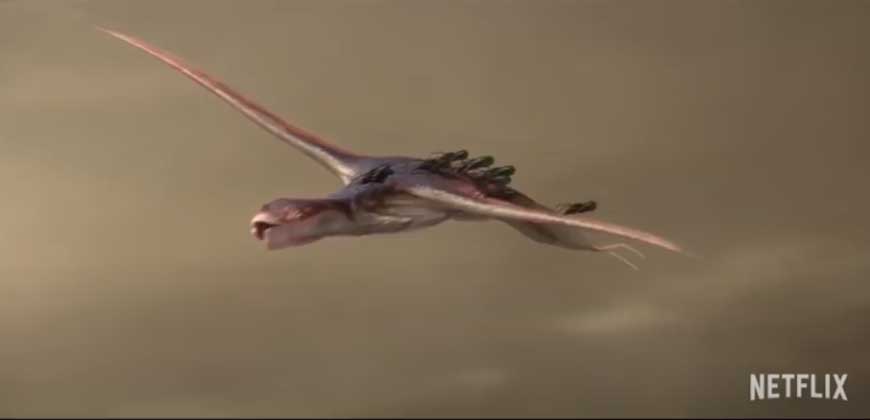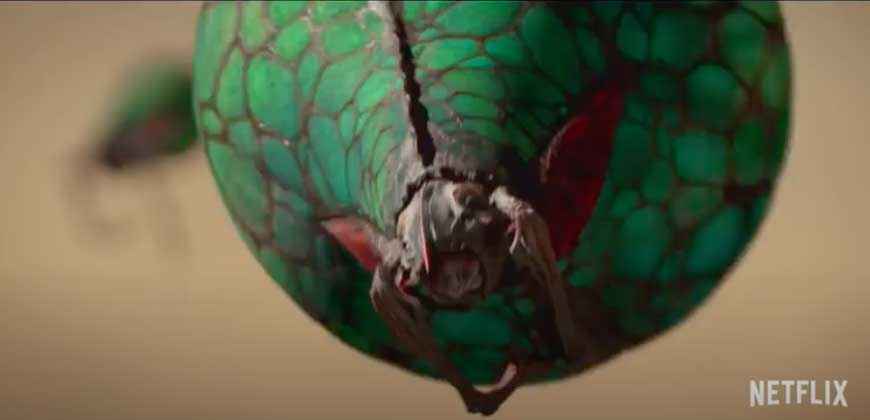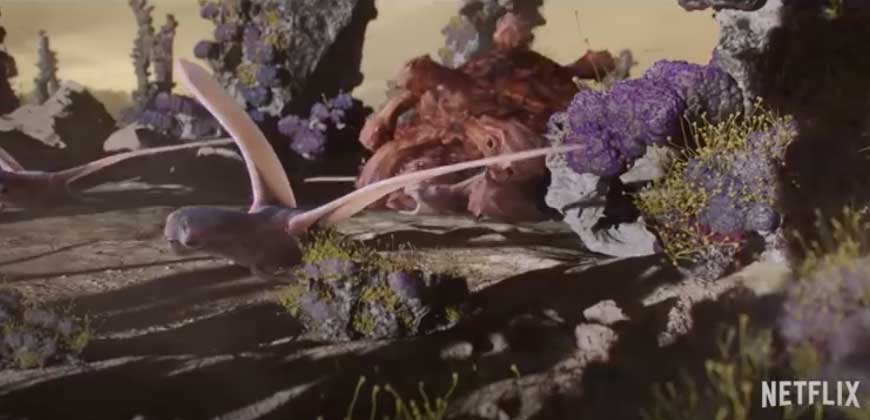
Floating predators. Googly-eyed monkeys. Sky cows. Brain matter in tanks. Sentient robots.
Netflix’s new series Alien Worlds covers them all. Each episode dreams up a fictional planet and the creatures who call it home. When you first see the odd critters and neon-colored plants, you may be tempted to dismiss the show as pure science fiction, but Alien Worlds is rooted in biology and evolution here on Earth.
What would happen to life on a planet where gravity was twice as strong? How would animals adapt to a planet around a dimmer star? Are we doomed to become a hive mind? Biologist and award-winning science fiction author, Philip Kramer, PhD, and Margaret Reeb, who works at the SETI Institute, have teamed up to break down the series.
SPOILER ALERT!
Margaret: Okay, Phil. Before we get into the nitty gritty of the show, let’s start with an important question: Do you believe life exists beyond Earth?
Philip: I do believe there is life out there. It’s simply a matter of probability. As the show points out, there are more planets out there than grains of sand on Earth. At least a few of those should have that perfect cocktail of ingredients for life to emerge. The probability of intelligent life is much smaller but that doesn’t keep me from hoping.
Margaret: I’m glad you brought that up. The show doesn’t spend a lot of time discussing the differences between life generally and intelligent life. There are all types of intelligence, but when we say “intelligent life” we’re talking about organisms that can solve complex problems, grasp abstract concepts, and chat with us. I think this type of life is rare but unintelligent life is abundant. (That sounds rude.)
Phil: So, we’re in agreement. I liked how they set up the premise of using biology here on Earth to dream up alien life.
Margaret: Totally. This is actually the main premise of astrobiology, a cross-disciplinary field concerned with the origin and nature of life. I also want to say that Didier Queloz is a treasure.
Philip: He was the first person we meet in the show, right? He detected the first exoplanet (or planet outside of our solar system).
Margaret: He confirmed an exoplanet for the first time. 51 Pegasi b, or 51 Peg b. We figured there were other worlds, but we didn’t know for sure until Didier confirmed it. And 51 Peg b upended our theories about planet formation.
Philip: Speaking of planets, we should talk about Atlas, the fictional planet covered in the series’ first episode.
ATLAS
Sky grazers

Philip: Where do these sky grazers rank for you on the intelligence scale? To me they looked like big flying cows.
Margaret: I spent a lot of the episode trying to decide if they were cute. I don’t think they could hold a conversation with me, unfortunately. I liked the thick atmosphere concept. When they said the sky grazers never landed, I felt sorry for them. How would they sleep? Then I realized they are sort of like dolphins swimming in the ocean.
Philip: And sleeping isn’t something that all animals do in the same way. The dolphin, like you brought up, can switch half of its brain on and off at a time, so it’s never fully asleep.
Margaret: I did not know that. Another reason dolphins can’t be trusted.
Philip: And while the sky grazers used six wings to fly though the dense atmosphere, the seeds they ate used another method entirely. Buoyancy.
Margaret: Oh, yes. Those were the pods that floated around like dandelion seeds.
Philip: Yes, though not quite like a dandelion seed. A dandelion seed uses air resistance and drag to get around. It can’t go any higher than the breeze will take it. Buoyancy is an upward force generated by the displacement of the surrounding medium.
Margaret: Another thing to consider is Atlas orbits an F-type star, which is bigger and hotter than our sun, which is a G-type star. Atlas’ star would give off a lot more UV radiation than the sun, and I’m not sure how that sky grazer would hold up.
Philip: The skygrazers were very pale. Without some pigment to absorb light in their skin, their cells, no matter what they’re made of, would be susceptible to damage from ionizing radiation. That means there must be something blocking that radiation from reaching them. A thick atmosphere like the one on Venus is known to block most surface radiation. Or like Earth, Atlas might have a strong magnetosphere.
Floating Predators

Margaret: We’ve covered the sky cows, now on to their enemies, the floating predators.
Philip: These are going to haunt my nightmares. When they did the close up shot--
Margaret: Don’t say it! That shot of their toothy beak was unnecessary. I hated it.
Philip: I can’t decide if the beak reminds me more of an octopus’ beak or the bevel of a needle. Having teeth inside was overkill. Those remind me of the lamprey. If you look up a picture of one, you’ll see it has a radial cyclone of teeth it uses to do exactly what they were doing in this show -- attach to other fish to feed.
Margaret: I’ll take your word for it. I am intrigued by the way these predators used hydrogen-producing bacteria to move up and down in the atmosphere. Do any animals do this on Earth?
Philip: Bacteria release gaseous byproducts all the time, but I’m not aware of any symbiotic relationship to inflate an organism.
Margaret: I liked how they were drawing a comparison between the way these predators hunt and the way falcons hunt on Earth. The falcons hang out up high and dive down on unsuspecting prey.
Philip: I enjoyed that bit. As they say, “nobody ever looks up.”
Boneless scavengers

Philip: These will also be in my nightmares. This idea of a boneless blob sitting on prey to absorb it is not something I’m aware of occurring on Earth, so it’s unique to this planet.
Margaret: It was heartbreaking when they were picking off the baby skygrazers, but the show was making a good point about how tough it can be for young animals to survive.
Philip: They made a good case for why this lifeform will most likely outlive everything else on the planet. “It pays to be a generalist, not a specialist.” This thing didn’t appear to be a picky eater.
Biodiversity
Philip: The lack of biodiversity on Atlas really stuck out to me. Earth has a huge amount of biodiversity and we really only see a few things on Atlas. My guess is the creators didn’t have the time to make millions of life forms.
Margaret: I did like how they brought up catastrophic events like asteroid impacts that can change the course of evolution on a planet.
Philip: Yes, and we know that happens because it’s happened here on earth. We’ve had catastrophic events that have wiped out millions of species and made way for new ones. You get a hint of that danger for Atlas from the presence of a ring around the planet. Fragments from whatever those rings once composed could have rained down on the planet.
Margaret: Yeah, that was a nice touch. It reminded me of Saturn, whose rings are chunks of asteroids and comets that got caught in Saturn’s gravity and eventually broke apart under the tidal forces.
Philip: Another thing that surprised me was the lack of water.
Margaret: Yes! Water is extremely important, and the show really dives into this in the next episode.





